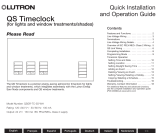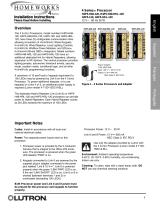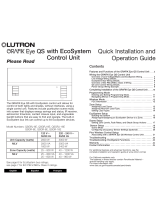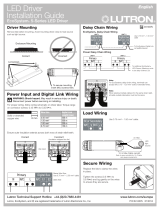®
Lutron Electronics Co. Inc.
Garanzia limitata di 1 anno
Per un periodo di un anno dalla data di acquisto e nel rispetto delle
esclusioni e delle restrizioni descritte di seguito, Lutron garantisce che
ogni unità nuova è priva di difetti di fabbricazione. A propria discrezione,
Lutron potrà scegliere di riparare l’unità difettosa o rilasciare al Cliente
un credito pari al prezzo di acquisto dell’unità difettosa corrispondente
al prezzo di un elemento sostitutivo equivalente venduto da Lutron.
L’elemento sostitutivo dell’unità fornito da Lutron o, a propria discrezione,
da un fornitore approvato può essere nuovo, usato, riparato, revisionato
e/o fabbricato da un produttore diverso.
Se l’unità viene messa in esercizio da Lutron o soggetto terzo
approvato da Lutron come componente di un sistema di controllo
dell’illuminazione commissionato da Lutron, la scadenza della presente
garanzia verrà estesa ed eventuali crediti legati al costo dei pezzi
sostitutivi verranno ripartiti, in conformità alla garanzia rilasciata con il
sistema commissionato, ad eccezione del fatto che la durata della
garanzia dell’unità verrà fatta partire dalla data della sua messa in opera.
ESCLUSIONI E LIMITAZIONI
La presente Garanzia non copre, e Lutron e i propri fornitori non
potranno essere ritenuti responsabili per:
1. Danni, malfunzionamenti o mancata operatività rilevati da Lutron o
terzi approvati da Lutron dovuti a normale usura, cattivo uso, uso
inadeguato, installazione errata, negligenza, incidenti, interferenze
o fattori ambientali, quali (a) utilizzo di tensioni di linea, fusibili
o interruttori automatici errati; (b) installazione, manutenzione e
funzionamento dell’unità non conformi alle istruzioni di funzionamento
fornite da Lutron, nonché alle disposizioni vigenti del National
Electrical Code e agli standard di sicurezza UL (Underwriter’s
Laboratories); (c) utilizzo di dispositivi o accessori non compatibili;
(d) ventilazione errata o insufficiente; (e) riparazioni o regolazioni
non autorizzate; (f) vandalismo o (g) cause di forza maggiore come
incendi, fulmini, inondazioni, tifoni, terremoti, tempeste, uragani o altri
eventi catastrofici che esulano dal controllo di Lutron.
2. Costi per il personale inviato presso il luogo di installazione, per
verificare i problemi, rimuovere, riparare, sostituire, configurare,
reinstallare e/o riprogrammare l’unità o i relativi componenti.
3. Attrezzature e componenti esterni all’unità, ivi compresi quelli venduti
o forniti da Lutron (che possono essere coperti da una garanzia
separata).
4. Costi per la riparazione o sostituzione di altri beni danneggiati a seguito
del funzionamento non corretto dell’unità, anche nel caso in cui tali
danni siano stati causati dall’unità.
AD ECCEZIONE DI QUANTO ESPRESSAMENTE PREVISTO DALLA
PRESENTE GARANZIA, LUTRON NON RILASCIA GARANZIE ESPRESSE
O IMPLICITE DI ALCUN TIPO, IVI COMPRESE EVENTUALI GARANZIE
DI ADEGUATEZZA PER UNO SCOPO PRECISO O GARANZIE DI
COMMERCIABILITÀ. LUTRON NON GARANTISCE CHE L’UNITÀ
FUNZIONERÀ SENZA INTERRUZIONI O ERRORI.
NESSUN AGENTE, DIPENDENTE O RAPPRESENTANTE DI
LUTRON HA L’AUTORITÀ DI VINCOLARE LUTRON A QUALSIASI
AFFERMAZIONE, DICHIARAZIONE O GARANZIA RELATIVA ALL’UNITÀ.
A MENO CHE UN’AFFERMAZIONE, DICHIARAZIONE O GARANZIA
RILASCIATA DA UN AGENTE, DIPENDENTE O RAPPRESENTANTE
NON SIA SPECIFICATAMENTE INCLUSA ALLA PRESENTE, O NEL
MATERIALE STANDARD FORNITO DA LUTRON, NON DOVRÀ
INTENDERSI PARTE INTEGRANTE DELL’ACCORDO INTERVENUTO
TRA LUTRON E IL CLIENTE E NON POTRÀ IN ALCUN MODO ESSERE
FATTO VALORE DA PARTE DEL CLIENTE.
IN NESSUN CASO LUTRON O ALTRI SOGGETTI SARANNO
RITENUTI RESPONSABILI PER RISARCIMENTI ESEMPLAR I,
DANNI CONSEQUENZIALI, INCIDENTALI O SPECIALI (INCLUDENDO
A TITOLO ESEMPLIFICATIVO MA NON ESAUSTIVO DANNI PER
LUCRO CESSANTE, PERDITA DI INFORMAZIONI RISERVATE O DI
ALTRA NATURA O PRIVACY, INTERRUZIONE DELL’ATTIVITÀ, LESIONI
PERSONALI, MANCATO RISPETTO DI IMPEGNI PRESI, COMPRESO IN
CASO DI BUONA FEDE O RAGIONEVOLE DILIGENZA, NEGLIGENZA
O PERDITE PECUNIARIE O DI QUALSIASI ALTRA NATURA), NÉ PER
RIPARAZIONI ESEGUITE SENZA IL PREVIO CONSENSO SCRITTO
DI LUTRON CONSEGUENTI O IN QUALSIASI MODO COLLEGATE
ALL’INSTALLAZIONE, LA DISINSTALLAZIONE, L’UTILIZZO O
L’IMPOSSIBILITÀ A UTILIZZARE L’UNITÀ O, IN OGNI MODO, AI SENSI
O IN RELAZIONE A QUALSIASI DISPOSIZIONE DELLA PRESENTE
GARANZIA O ACCORDI DI CUI LA PRESENTE GARANZIA FA PARTE,
ANCHE IN CASO DI COLPA, ATTO ILLECITO (INCLUSA NEGLIGENZA),
RESPONSABILITÀ DIRETTA, VIOLAZIONE DI CONTRATTO O
VIOLAZIONE DI GARANZIA DA PARTE DI LUTRON O SUOI FORNITORI,
ANCHE QUANDO LUTRON O ALTRI SOGGETTI FOSSERO STATI
AVVISATI DEL POSSIBILE VERIFICARSI DI TALI DANNI.
INDIPENDENTEMENTE DAI DANNI CHE IL CLIENTE DEBBA
SOSTENERE PER QUALSIASI MOTIVO (INCLUDENDO A TITOLO
ESEMPLIFICATIVO MA NON ESAUSTIVO TUTTI I DANNI DIRETTI
E I DANNI ELENCATI NEL PRECEDENTE PARAGRAFO), LA
RESPONSABILITÀ COMPLESSIVA DI LUTRON E DI TUTTE LE PARTI
INTERESSATE NELLA PRESENTE GARANZIA IN CASO DI RICHIESTA
DI RIMBORSO DI DANNI CONSEGUENTI O COLLEGATI ALLA
PRODUZIONE, LA VENDITA, L’INSTALLAZIONE, LA CONSEGNA,
L’UTILIZZO, LA RIPARAZIONE O LA SOSTITUZIONE DELL’UNITÀ, O
ALTRI ACCORDI IN CUI COMPAIA LA PRESENTE GARANZIA, E IL
RIMEDIO ESCLUSIVO A DISPOSIZIONE DEL CLIENTE PER QUANTO
SOPRA ESPOSTO SARANNO LIMITATI ALLA SOMMA PAGATA A
LUTRON DAL CLIENTE PER L’ACQUISTO DELL’UNITÀ. LE LIMITAZIONI,
LE ESCLUSIONI E GLI ESONERI DI RESPONSABILITÀ APPENA
ILLUSTRATI SARANNO VALIDI PER L’ENTITÀ MASSIMA CONSENTITA
DALLA LEGGE VIGENTE, ANCHE NEI CASI IN CUI UN RIMEDIO
SPECIFICO NON RISPONDA AL SUO SCOPO PRECIPUO.
RICHIESTA DI APPLICAZIONE DELLA GARANZIA
Per presentare una richiesta in garanzia, rivolgersi immediatamente
a Lutron entro il periodo di garanzia indicato sopra chiamando il Centro
di assistenza tecnica della società al numero (800) 523-9466. Lutron, a
propria discrezione, stabilirà l’azione da svolgere in base alla garanzia, se
del caso. Per consentire a Lutron una migliore individuazione del problema,
tenere a portata di mano il numero di serie e il modello dell’unità prima
di effettuare la telefonata. Se, a propria discrezione, Lutron stabilisce
la necessità di una visita presso la sede del cliente o di altro intervento
risolutivo, la società potrà inviare un rappresentante Lutron Services Co.
o predisporre la visita dell’agente di un fornitore approvato Lutron presso
il Cliente, e/o programmare una chiamata di assistenza in garanzia tra il
Cliente e un fornitore approvato Lutron.
La presente garanzia fornisce all’acquirente specifici diritti legali.
L’acquirente può inoltre godere di eventuali altri diritti concessi dalla
normativa applicabile nel proprio paese. Alcuni stati non prevedono
limitazioni sulla durata della garanzia implicita, pertanto la limitazione
di cui sopra potrebbe non essere applicabili a voi. Alcuni stati non
prevedono l’esclusione o la limitazione dei danni diretti o indiretti,
pertanto la limitazione di cui sopra potrebbe non essere applicabili a voi.
Questi prodotti possono essere coperti da uno o più dei seguenti
brevetti registrati negli Stati Uniti: 5,191,265; 5,430,356; 5,463,286;
5,838,226; 5,848,054; 5,905,442; 5,949,200; 5,982,103; 6,091,205;
6,188,181; 6,380,692; 6,687,487; 6,803,728; D546,294; D547,733;
D547,734; D550,163; D550,164; D550,165; D550,166; D551,179;
D552,042; e dei brevetti corrispondenti registrati in altri paesi. Possono
esservi altri brevetti USA o in altri paesi in corso di registrazione.
NEC è un marchio registrato di National Fire Protection Association,
Inc., Quincy, Massachusetts.
Lutron, il logo Sunburst, Sivoia, seeTouch, e GRAFIK Eye sono
marchi registrati e Radio Powr Savr è sono marchi di Lutron Electronics
Co., Inc.
© 2010 Lutron Electronics Co., Inc.
Sito Internet: www.lutron.com
E-mail: product@lutron.com
SEDE PRINCIPALE
USA
Lutron Electronics Co., Inc.
7200 Suter Road, Coopersburg, PA 18036-1299
TEL +1.610.282.3800
FAX +1.610.282.1243
Numero verde 1.888.LUTRON1
Assistenza tecnica 1.800.523.9466
Assistenza tecnica telefonica per America
Settentrionale e Meridionale
U.S.A., Canada, zona caraibica: 1.800.523.9466
Messico: +1.888.235.2910
America centrale/meridionale: +1.610.282.6701
SEDE PRINCIPALE IN EUROPA
Regno Unito
Lutron EA Ltd.
6 Sovereign Close, Londra, E1W 3JF Regno Unito
TEL +44.(0)20.7702.0657
FAX +44.(0)20.7480.6899
NUMERO VERDE (UK) 0800.282.107
Assistenza tecnica +44.(0)20.7680.4481
SEDE IN ASIA
Singapore
Lutron GL Ltd.
15 Hoe Chiang Road, #07-03 Euro Asia Centre,
Singapore 089316
TEL +65.6220.4666
FAX +65.6220.4333
Assistenza Tecnica - Asia
Cina settentrionale: 10.800.712.1536
Cina meridionale: 10.800.120.1536
Hong Kong: 800.901.849
Indonesia: 001.803.011.3994
Giappone: +81.3.5575.8411
Macao: 0800.401
Singapore: 800.120.4491
Taiwan: 00.801.137.737
Tailandia: 001.800.120.665853
Per gli altri paesi: +65.6220.4666
Garanzia
Lutron Electronics Co., Inc.
Made and printed in U.S.A.
P/N 032-310 Rev. A 03.18.10
Indirizzi sedi Lutron


































































































































